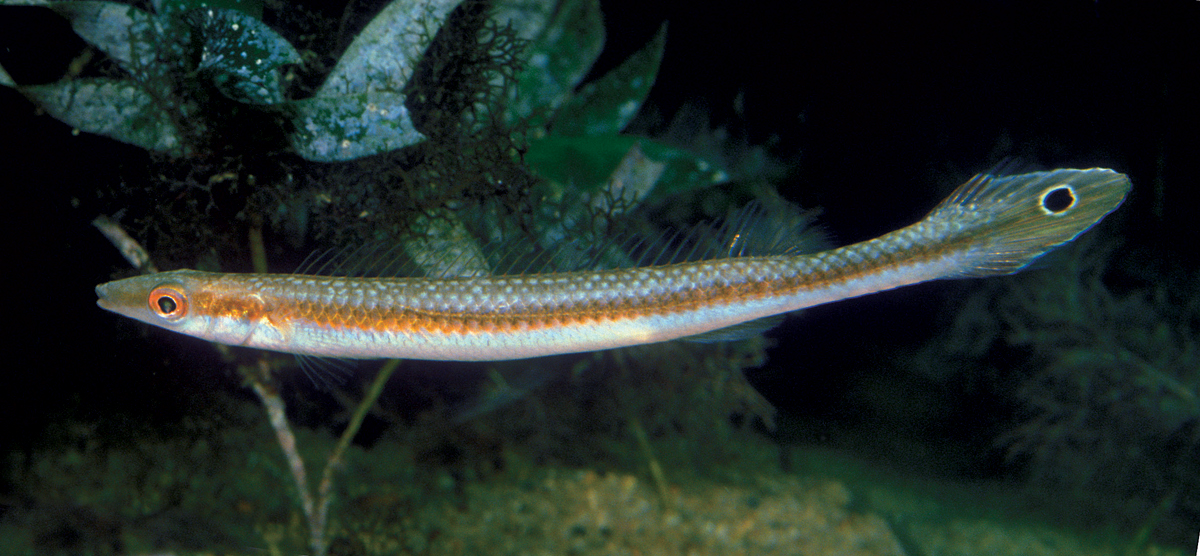Slender Weed Whiting, Siphonognathus attenuatus (Ogilby 1897)
Other Names: Short-nose Weed Whiting, Short-snouted Pencil Weed Whiting, Slender Rock Whiting

A female Slender Weed Whiting, Siphonognathus attenuatus. Source: Rudie H. Kuiter / Aquatic Photographics. License: All rights reserved
Summary:
A small tan coloured weed whiting with a white underside, a brown midlateral stripe and a prominent black ocellus or 'false eye-spot' on the caudal fin. Males have yellow pelvic fins with a black base and white-edged black spots distally.
Cite this page as:
Bray, D.J. 2021, Siphonognathus attenuatus in Fishes of Australia, accessed 10 Jul 2025, https://fishesofaustralia.net.au/Home/species/302
Slender Weed Whiting, Siphonognathus attenuatus (Ogilby 1897)
More Info
|
Distribution |
Endemic to southern Australia from west of Cape Conran, eastern Bass Strait, Victoria, to Rottnest Island, Western Australia, including the Bass Strait islands and eastern Tasmania. Inhabits sandy patches in coastal waters adjacent to macroalgal and seagrass beds, and rocky outcrops, commonly at depths of 15–20 m. |
|
Features |
Dorsal fin IX–XXI, 14–16; Anal fin III, 7–8; Caudal fin 12; Pectoral fin 13–15; Pelvic fin I, 4; Lateral line scales 38–45. Body very slender (8-10% SL), very elongate, compressed; caudal peduncle long and shallow (caudal peduncle depth 28-34% caudal peduncle length). Head moderately small (23-25% SL), snout of moderate length (28-33% HL), pointed, eyes of moderate size (21-26 % HL); mouth small (upper jaw length 16-21%), reaching almost half way to front edge of eye; teeth mostly fused into pavement like beak. Scales of moderate size, cycloid, covering body and part of head including most of opercle and rear of cheek, predorsal scales reaching forward almost to above front edge of eye; lateral line nearly straight but with low dorsal curve above pectoral fin. Single dorsal fin with long base and uniform height, anal fin short, about one fourth length of dorsal. Pectoral fin rounded. Pelvic fin short, arising slightly behind and below pectoral fin base. |
|
Colour |
Tan above, white below with broad dark brown stripe midlaterally; caudal fin with prominent black spot circled with white; pelvic fins in males yellow with black base and white-edged black spots distally. |
|
Etymology |
The specific name is from the Latin attenuatus (= drawn out, tapering), in reference to the long slender body - "the great tenuity of the head and body". |
|
Species Citation |
Odax attenuatus Ogilby, 1897, Proc. Linn. Soc. N.S.W. 22: 83. Type locality: Tasmania. |
|
Author |
Bray, D.J. 2021 |
|
Resources |
Slender Weed Whiting, Siphonognathus attenuatus (Ogilby 1897)
References
Clements, K.D., Alfaro, M.E., Fessler, J.L. & Westneat, M.W. 2004. Relationships of the temperate Australasian labrid fish tribe Odacini (Perciformes; Teleostei). Molecular Phylogenetics & Evolution 32: 575-587.
Edgar, G.J. 2008. Australian Marine Life: the plants and animals of temperate waters. 2nd edn Sydney : Reed New Holland, 624 pp.
Edgar, G.J., Last, P.R. & Wells, M.W. 1982. Coastal Fishes of Tasmania and Bass Strait. Hobart : Cat & Fiddle Press 175 pp.
Gomon, M.F. 1994. Family Odacidae. pp. 700-710 figs 612-621 in Gomon, M.F., Glover, C.J.M. & Kuiter, R.H. (eds). The Fishes of Australia's South Coast. Adelaide : State Printer 992 pp. 810 figs.
Gomon. M.F. 2008. Family Odacidae. pp. 659-667 in Gomon, M.F., Bray, D.J. & Kuiter, R.H. (eds). Fishes of Australia's Southern Coast. Sydney : Reed New Holland 928 pp.
Gomon, M.F. & Paxton, J.R. 1986. A revision of the Odacidae, a temperate Australian-New Zealand labroid fish family. Indo-Pacific Fishes 8: 1-57 figs 1-21 pls 1-6
Hoschke, A., Whisson, G. & Moore, G.I. 2019. Complete list of fishes from Rottnest Island. pp. 150-161 in Whisson, G. & Hoschke, A. (eds) The Rottnest Island fish book. 2nd ed. Perth: Aqua Research & Monitoring Services.
Hutchins, J.B. & Swainston, R. 1986. Sea Fishes of Southern Australia. Complete field guide for anglers and divers. Perth : Swainston Publishing 180 pp.
Hutchins, J.B. & Thompson, M. 1983. The Marine and Estuarine Fishes of South-western Australia. Perth : Western Australian Museum 103 pp. 345 figs.
Kuiter, R.H. 1993. Coastal Fishes of South-eastern Australia. Bathurst : Crawford House Press 437 pp.
Kuiter, R.H. 1996. Guide to Sea Fishes of Australia. A comprehensive reference for divers and fishermen. Sydney, NSW, Australia : New Holland Publishers xvii, 434 pp.
Kuiter, R.H. 2010. Labridae fishes: wrasses. Seaford, Victoria, Australia : Aquatic Photographics 398 pp. (as Sheardichthys attenuatus)
Last, P.R., Scott, E.O.G. & Talbot, F.H. 1983. Fishes of Tasmania. Hobart : Tasmanian Fisheries Development Authority 563 pp. figs.
MacArthur, L.D. & Hyndes, G.A. 2001. Differential use of seagrass assemblages by a suite of odacid species. Estuarine, Coastal and Shelf Science 52: 79-90.
May, J.L. & Maxwell, J.G.H. 1986. Trawl fish from temperate waters of Australia. CSIRO Division of Fisheries Research, Tasmania. 492 pp.
Ogilby, J.D. 1897. New genera and species of Australian fishes. Proceedings of the Linnean Society of New South Wales 22(1): 62-95 See ref at BHL
Russell, B., Clements, K.D., Choat, J.H., Rocha, L.A., Myers, R., Lazuardi, M.E., Muljadi, A., Pardede, S. & Rahardjo, P. 2012. Siphonognathus attenuatus. The IUCN Red List of Threatened Species 2012: e.T190682A17774922. https://dx.doi.org/10.2305/IUCN.UK.2012.RLTS.T190682A17774922.en. Downloaded on 17 March 2021.








